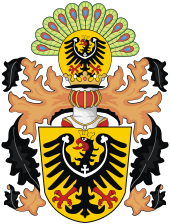
Back تاريخ سيليزيا Arabic Geschichte Schlesiens German Historia de Silesia Spanish Storia della Slesia Italian Historia Śląska Polish Gyszichta Ślůnska SZL


In the second half of the 2nd millennium B.C. (late Bronze Age), Silesia belonged to the Lusatian culture. About 500 BC Scyths arrived, and later Celts in the South and Southwest.[1] During the 1st century BC Silingi and other Germanic people settled in Silesia. For this period we have written reports of antique authors who included the area. Slavs arrived in this territory around the 6th century. The first known states in Silesia were those of Greater Moravia and Bohemia. In the 10th century, Mieszko I incorporated Silesia into Civitas Schinesghe, a Polish state. It remained part of Poland until the Fragmentation of Poland. Afterwards it was divided between Piast dukes, descendants of Władysław II the Exile, High Duke of Poland.
In the Middle Ages, Silesia was divided among many duchies ruled by various dukes of the Piast dynasty. During this time, cultural and ethnic German influence increased due to immigrants from the German-speaking components of the Holy Roman Empire, as the region's economy developed, and towns were founded under German town law.
Between the years 1289–1292 Bohemian king Wenceslaus II became suzerain of some Upper Silesian duchies. Silesia subsequently became a possession of the Crown of Bohemia under the Holy Roman Empire in the 14th century, and passed with that Crown to the Habsburg monarchy in 1526. The Duchy of Crossen was inherited by the Margraviate of Brandenburg in 1476 and, with the renunciation by King Ferdinand I and estates of Bohemia in 1538, it became an integral part of Brandenburg.
In 1742, most of Silesia was seized by King Frederick the Great of Prussia in the War of the Austrian Succession and subsequently made the Prussian Province of Silesia.
After World War I, Lower Silesia, having by far a German majority, remained with Germany while Upper Silesia, after a series of insurrections by the Polish inhabitants, was split. Part joined the Second Polish Republic and was administered as the Silesian Voivodeship. The Prussian Province of Silesia within Germany was divided into the Provinces of Lower Silesia and Upper Silesia. Austrian Silesia (officially: Duchy of Upper and Lower Silesia; almost identical with modern-day Czech Silesia), the small portion of Silesia retained by Austria after the Silesian Wars, became part of the new Czechoslovakia. During the Second World War, Nazi Germany invaded Polish parts of Upper Silesia. Jews were subject to genocide in the Holocaust, while German plans towards Poles involved ethnic cleansing and biological extermination.[2]
In 1945 both provinces were occupied by the Soviet Union. Under the demands in the Potsdam Agreement, most of this territory was afterwards transferred to the Polish People's Republic. Most of the German population, who had not been evacuated or had fled, were expelled by the newly arrived Polish administration, while Poles expelled from the eastern Polish Borderlands then settled in the region.
- ^ "Schlesien".
- ^ Element polski zaś miał być ze Śląska usunięty przez zastosowanie różnych form wysiedleń do Generalnej Gubernii do biologicznej eksterminacji włącznie.Górny Śląsk: szczególny Mirosława Błaszczak-Wacławik J. Szumacher, 1990, page 44 -